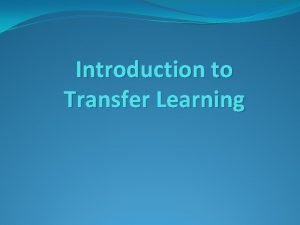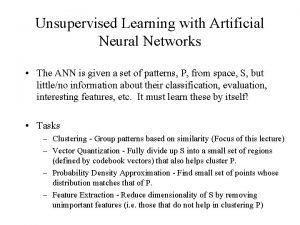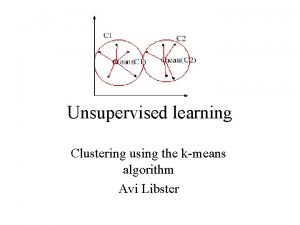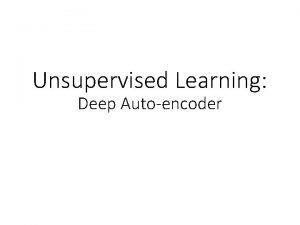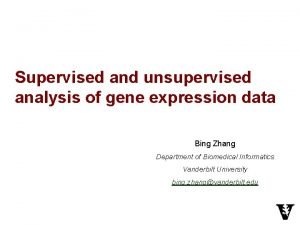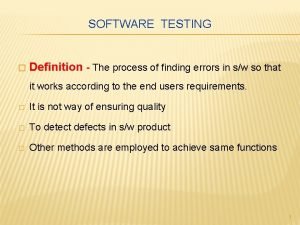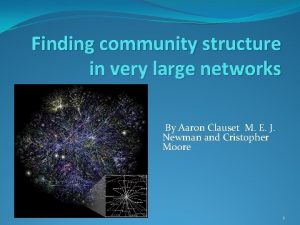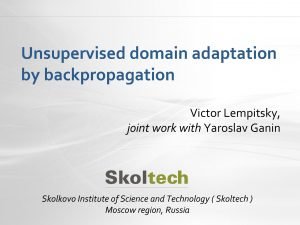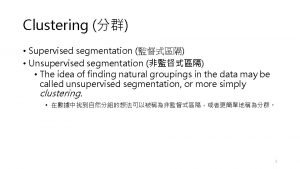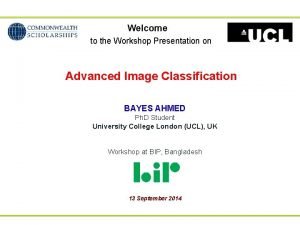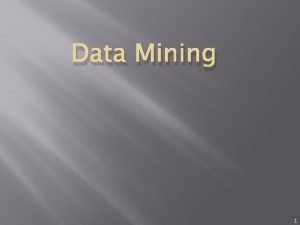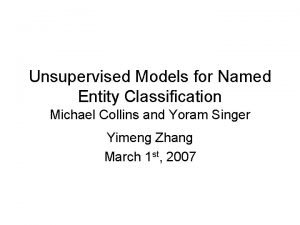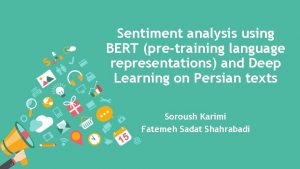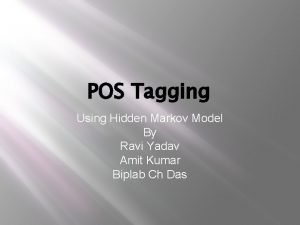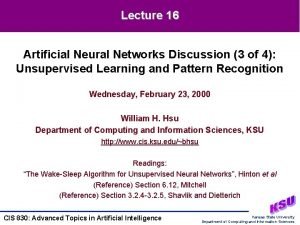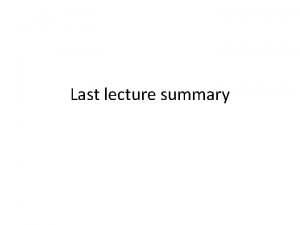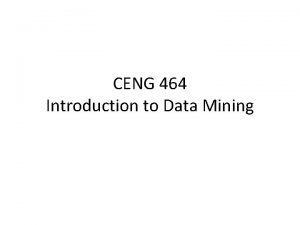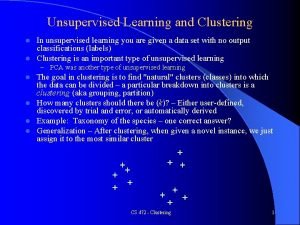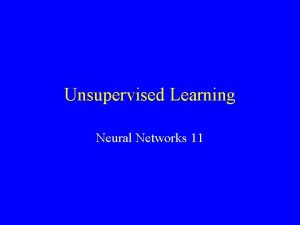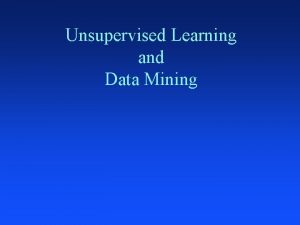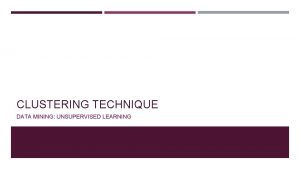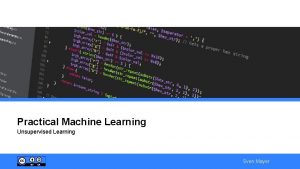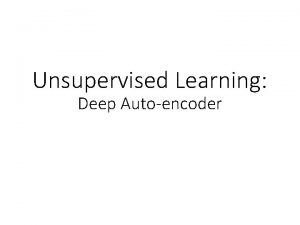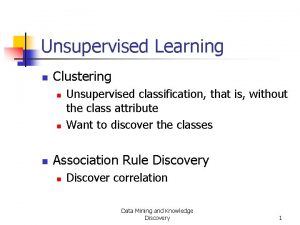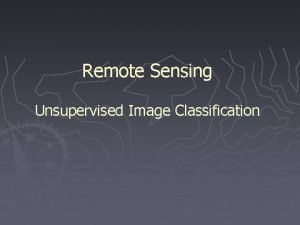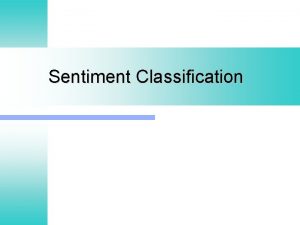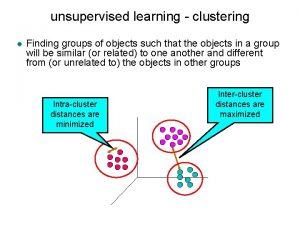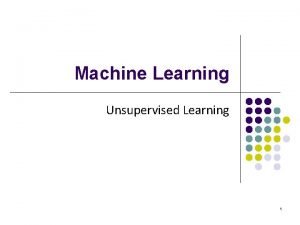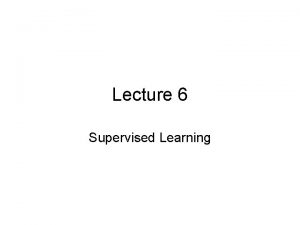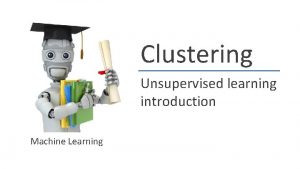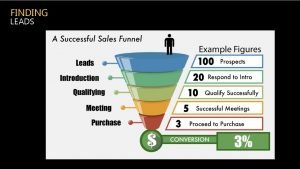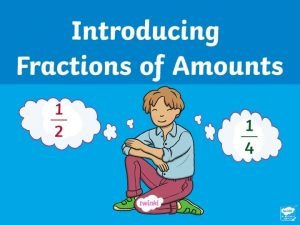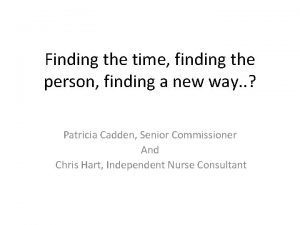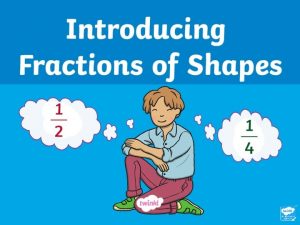Unsupervised learning is the process of finding structure





























- Slides: 29

Unsupervised learning is the process of finding structure, patterns or correlation in the given data. we distinguish: • Unsupervised Hebbian learning – Principal component analysis • Unsupervised competitive learning – Clustering – Data compression 2/28/2021 Rudolf Mak TU/e Computer Science 1

Unsupervised Competitive Learning In unsupervised competitive learning the neurons take part in some competition for each input. The winner of the competition and sometimes some other neurons are allowed to change their weights • In simple competitive learning only the winner is allowed to learn (change its weight). • In self-organizing maps other neurons in the neighborhood of the winner may also learn. 2/28/2021 Rudolf Mak TU/e Computer Science 2

Applications • Speech Recognition • OCR, e. g. handwritten characters • Image compression – (using code-book vectors) • Texture maps – Classification of cloud pattern (cumulus etc. ) • Contextual maps 2/28/2021 Rudolf Mak TU/e Computer Science 3

Network topology For simple competitive learning the network consists of a single layer of linear neurons each connected to all inputs. Lateral inhibition not indicated 2/28/2021 Rudolf Mak TU/e Computer Science 4

Definition of the Winner There are various criteria to define which neuron i becomes the winner of the competition for input x: • • When the weights are normalized these criteria are identical as can be seen from the equation 2/28/2021 Rudolf Mak TU/e Computer Science 5

Training Set A training set for unsupervised learning consists only of input vectors (no targets!) Given a network with weight matrix W the training set can be partitioned into clusters Xi according to the classification made by the network 2/28/2021 Rudolf Mak TU/e Computer Science 6

Simple Competitive Learning (incremental version) This technique is sometimes called ‘the winner takes it all’ 2/28/2021 Rudolf Mak TU/e Computer Science 7

Convergence (incremental version) • Unless the learning parameter tends to 0, the incremental version of simple competitive learning does not convergence • In absence of convergence the weight vectors oscillate around the centers of their clusters 2/28/2021 Rudolf Mak TU/e Computer Science 8

Simple Competitive Learning (batch version) 2/28/2021 Rudolf Mak TU/e Computer Science 9

Cluster Means Let ni be the number of element in cluster Xi. Then we define the mean mi of cluster i by Hence in the batch version the weight given by is So the weights of the winning neuron are moved in the direction of the mean of its cluster. 2/28/2021 Rudolf Mak TU/e Computer Science 10

Data Compression The final value of the weight vectors are sometimes called code-book vectors. This nomenclature stems from data compression applications. • Compress (encode) – Map vector x to code-word i = win (W, x) • Decompress (decode) – Map code-word i to code-book vector wi which is presumably close to the original vector x Note that this is a form of lossy data compression 2/28/2021 Rudolf Mak TU/e Computer Science 11

Convergence (batch version) • In the batch version of simple competitive learning the weight vector wi can be shown to converge to the mean of the input vectors that have i as winning neuron • In fact the batch version is a gradient descent method that converges to a local minimum of a suitably chosen error function 2/28/2021 Rudolf Mak TU/e Computer Science 12

Error Function For a network with weight matrix W and training set we define the error function E(W) by Let 2/28/2021 , then Rudolf Mak TU/e Computer Science 13

Gradients of the Error functions Because It follows that the gradient of the error in the i-th cluster is given by 2/28/2021 Rudolf Mak TU/e Computer Science 14

Minima are Cluster Means After termination of the learning algorithm all gradients are zero, i. e. for all i, 1 · i · k , So after learning the weight vectors of the nonempty clusters have converged to the mean vectors of those clusters. Note that learning stops in a local minimum, so better clusters may exist. 2/28/2021 Rudolf Mak TU/e Computer Science 15

Dead neurons & minima 2/28/2021 input 0 2 7 w 1 w 2 E winner 1 1 1 3 winner 1 1 2 1 7 1/3 winner 1 2 2 - - - winner 2 2 2 <-3 3 3. 5 >11 3. 5 Rudolf Mak TU/e Computer Science local global local 16

K-means clustering as SCL • K-means clustering is a popular statistical method to organize multi-dimensional data into K groups. • K-means clustering can be seen as an instance of simple competitive learning, where each neuron has its own learning rate. 2/28/2021 Rudolf Mak TU/e Computer Science 17

SCL (batch version) 2/28/2021 Rudolf Mak TU/e Computer Science 18

Move learning factor outside repetition 2/28/2021 Rudolf Mak TU/e Computer Science 19

Set individual learning rate 2/28/2021 Rudolf Mak TU/e Computer Science 20

Split 2/28/2021 such that Rudolf Mak TU/e Computer Science 21

Eliminate 2/28/2021 Rudolf Mak TU/e Computer Science 22

Introduce separate cluster variables 2/28/2021 Rudolf Mak TU/e Computer Science 23

Reuse mj 2/28/2021 : K-means clustering I Rudolf Mak TU/e Computer Science 24

K-means Clustering II 2/28/2021 Rudolf Mak TU/e Computer Science 25

Convergence of K-means Clustering The convergence proof of the K-means clustering algorithms involves showing two facts • Reassigning a vector to a different cluster does not increase the error function • Updating the mean of a cluster does not increase the error function 2/28/2021 Rudolf Mak TU/e Computer Science 26

Reassigning a vector Assume vector x(p) moves from cluster j to cluster i. Then it follows that Hence 2/28/2021 Rudolf Mak TU/e Computer Science 27

Updating the Mean of a Cluster Consider cluster Xi with old mean 2/28/2021 Rudolf Mak TU/e Computer Science and new 28

Non-optimal Stable Clusters 0 2/28/2021 3 6 8 Rudolf Mak TU/e Computer Science 10 29
 Supervised learning dan unsupervised learning
Supervised learning dan unsupervised learning Perbedaan supervised dan unsupervised
Perbedaan supervised dan unsupervised Unsupervised learning in data mining
Unsupervised learning in data mining Transductive learning for unsupervised text style transfer
Transductive learning for unsupervised text style transfer Autoencoders, unsupervised learning, and deep architectures
Autoencoders, unsupervised learning, and deep architectures Maxnet neural network
Maxnet neural network Workspca
Workspca Unsupervised learning
Unsupervised learning Andrew ng introduction to machine learning
Andrew ng introduction to machine learning Machine learning
Machine learning Autoencoder unsupervised learning
Autoencoder unsupervised learning Supervised and unsupervised learning
Supervised and unsupervised learning Cuadro comparativo de e-learning b-learning y m-learning
Cuadro comparativo de e-learning b-learning y m-learning Process of finding errors in software code
Process of finding errors in software code Finding community structure in very large networks
Finding community structure in very large networks Victor lempitsky
Victor lempitsky Unsupervised segmentation
Unsupervised segmentation Object based image analysis
Object based image analysis Supervised vs unsupervised data mining
Supervised vs unsupervised data mining Unsupervised models for named entity classification
Unsupervised models for named entity classification Sentiment analysis with deep learning using bert
Sentiment analysis with deep learning using bert Unsupervised pos tagging
Unsupervised pos tagging The wake-sleep algorithm for unsupervised neural networks
The wake-sleep algorithm for unsupervised neural networks Unsupervised hierarchical clustering
Unsupervised hierarchical clustering Generative adversarial networks
Generative adversarial networks Supervised vs unsupervised data mining
Supervised vs unsupervised data mining Hình ảnh bộ gõ cơ thể búng tay
Hình ảnh bộ gõ cơ thể búng tay Slidetodoc
Slidetodoc Bổ thể
Bổ thể Tỉ lệ cơ thể trẻ em
Tỉ lệ cơ thể trẻ em



